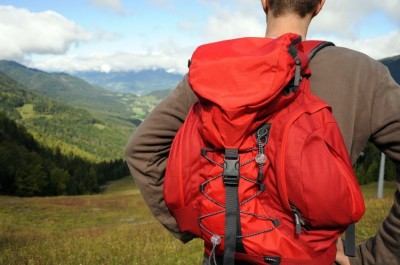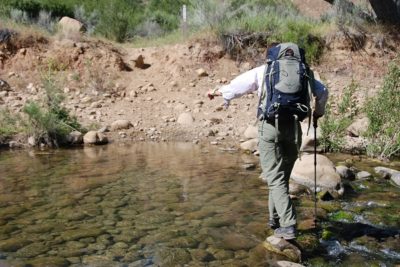~ how's 'bout we 300 +/- MILLIONS of U.S. ban 2 gether & make "them" bug the fuck out ! ...lets try that 1 ...once huh ?
 It seems like everyone is talking bug-out bags
these days. You can find countless articles online which talk about
what you should include in a well-stocked bug-out bag, as well as a
number of companies who are offering already filled bug-out bags for
sale. These range anywhere from the most basic of bags, with not much
more than food, water and a first-aid kit, to elaborate bug-out bags
which contain an excellent assortment of quality survival equipment.
It seems like everyone is talking bug-out bags
these days. You can find countless articles online which talk about
what you should include in a well-stocked bug-out bag, as well as a
number of companies who are offering already filled bug-out bags for
sale. These range anywhere from the most basic of bags, with not much
more than food, water and a first-aid kit, to elaborate bug-out bags
which contain an excellent assortment of quality survival equipment.The truth of the matter is that there is no one perfect bug-out bag. Having a bag full of equipment you don’t know how to use isn’t going to do a thing to protect your life. A lot depends upon how much knowledge you have to go with that bug-out bag and a lot depends upon where you are going to bug-out to.
Most bug-out bags share one common fault; they’re designed to help you survive three days, nothing more. That means that on the fourth day, when your supplies start running out, you’re going to start going hungry.
Considering that most bug-out situations last more than three days, the whole concept of a bug-out bag is rather limited. It might get you to the next city down the road, but that’s about it. If you are going to have to live off of what you’re carrying, you’re going to need more than that bug-out bag can provide. In addition to the survival equipment that the bag probably has, you’re going to need more food, water, clothing and other supplies.
What if you could take more with you? How would that make a difference? What if you weren’t limited by the space in your backpack? What should you take along then?
The pack for anybody who wants to be fully prepared for an unexpected emergency
Many people intend to bug-out in their car, truck or SUV. If that’s your plan, then you might want to consider taking full advantage of that vehicle, especially the storage space that it provides. While there’s a pretty good chance that you may have to abandon your vehicle along the way, you might also be able to take it all the way to your destination, especially if you manage to beat the rush and bug out before everyone else does.
So, if you’re going to fill up all that extra space, what should you take with you?
- More food – There’s really no such thing as taking too much food with you. However, you want the extra food that you are carrying to meet the same criteria as the food in your bug-out bag. That is, food that has a high amount of nutrition and energy for the volume, as well as being low-weight for easy carrying.
- More water – Water really isn’t as much of an issue in most places with the ability to purify water. However, if you are crossing any arid areas, you’ll want to take extra water along with you. If you can’t find a source of water to purify, having that water with you can keep you going for a little more time.
- Clothing – Most bug-out bag lists don’t include anything about clothing. The general idea is that you use the clothes on your back. If you’re only going to have to wear that outfit for three days, that’s not all that bad. But if you’re going to be out in the wild for months, you’ll definitely want some extra clothing.
 Coats –
Even if you’re bugging out in the summer, you need to take coats along.
Weather can change quickly, especially when you’re in the high country,
trying to survive out in the wild. If you are out for months, you might
even end up finding winter creeping up on you.
Coats –
Even if you’re bugging out in the summer, you need to take coats along.
Weather can change quickly, especially when you’re in the high country,
trying to survive out in the wild. If you are out for months, you might
even end up finding winter creeping up on you.- Tools – The average bug-out bag doesn’t contain many tools. Oh, it may have a multi-tool, a wire saw, a camp shovel and a hatchet, but not what anyone would call real tools. While those tools are good for creating an emergency shelter, can you imagine trying to build yourself a long-term shelter with them? You’ll be much better off if you can take some larger, more robust tools with you.
- A better first-aid kit – The average bug-out bag first-aid kit is rather limited. It will have bandages for small injuries, as well as some pain reliever and over-the-counter medicines. A larger first-aid kit, which provides the capability to deal with larger wounds might come in handy.
- Sleeping bags – Bug-out bags don’t normally include sleeping bags, unless they are of the emergency space blanket variety. Sleeping bags are bulky, which is why they are normally left out. However, there is no one piece of additional equipment which will do more to keep you comfortable.
- A tent – You might have a compact backpacking tent included as part of your bug-out bag. If you do, good for you. If not, a camping tent could provide you with a better shelter than a lean-to or debris shelter, while you are working on building your long-term shelter.
- Toilet paper – Yes, I actually included this. If you’re going to be stuck out in the wild for a while, you might get tired of using leaves. While it may not seem all that important, it will make you more comfortable.
- Additional hunting and fishing gear – Most people include a weapon of some sort in their bug-out bag and it’s not unusual to include a small fishing kit. But if you’re planning on eating what nature provides, you’d better be ready to harvest it. That might mean that you need additional weapons, ammo and fishing gear.
Another option to consider is making yourself some sort of wheeled carrier to carry these bags with. While a hand truck might be a little bit inconvenient over rough ground, something similar, with larger wheels might work out quite well. When I was a kid, my dad built a “burro” with a bicycle wheel and aluminum tubing. He would take it hunting with him, so that he could carry out any deer that he killed. The one wheeled burro would support the weight of the deer and handles on both ends allowed two men to guide it along, much like carrying a stretcher. It even had a caliper brake to keep it from getting out of control on the downhill slope.
Regardless of what else you take with you, it’s important that your bug-out bag remain your bug-out bag. If that’s all you can grab, you want to make sure it’s as complete as possible. The rest of this is additional equipment, not a larger bug-out bag. If you have to abandon your vehicle along the way, your bug-out bag may be all that you can take with you. In either case, you want to make sure that your bug-out bag is as complete as possible.
No comments:
Post a Comment